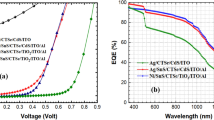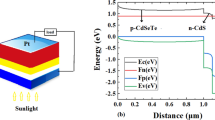Abstract
CdTe solar cells are investigated using a solar cell capacitance simulator software. First, a conventional fluorine-doped tin oxide (FTO)/i-SnO2/CdS/CdTe structure is simulated using input experimental data to verify the simulation process. To make the cell more economical, the thickness of the CdTe layer is decreased, resulting in a degradation of the device performance. To decrease the minority-carrier recombination loss of the designed structure, a p-type Cu2O layer is exploited at the back contact as a hole transport electron blocking layer (HT–EBL). To address the performance degradation, a ZnS/CdS bilayer is used as the window layer. The interdiffusion of Cd into the ZnS due to annealing treatment and the formation of ZnxCd1−xS compound are also studied. Cell parameters include the thickness, doping concentration, and carrier lifetime are then optimized to enhance the power conversion efficiency (PCE). The proposed FTO/i-SnO2/Zn0.5Cd0.5S/CdTe/Cu2O configuration shows the best PCE of 17.5%, short-circuit current density (Jsc) of 27.8 mA/cm2, open-circuit voltage (Voc) of 0.87 V, and fill factor of 72.34% under AM1.5G illumination.











Similar content being viewed by others
References
Swanson, D.E., Sites, J.R., Sampath, W.S.: Co-sublimation of CdSex Te1−x layers for CdTe solar cells. Sol. Energ. Mater. Sol. C. 159, 389–394 (2017)
Green, M.A., Hishikawa, Y., Dunlop, E.D., Levi, D.H., Hohl-Ebinger, J., Yoshita, M., HoBaillie, A.W.Y.: Solar cell efficiency tables (ver, 53). Prog. Photovolt. Res. Appl. 27, 3–12 (2019)
Wu, X.: High-efficiency polycrystalline CdTe thin-film solar cells. Sol. Energy 77, 803–814 (2004)
Romeo, A., Terheggen, M., Abou-Ras, D., Bätzner, D.L., Haug, F.J., Kälin, M., Rudmann, D., Tiwari, A.N.: Development of thin-film Cu(In, Ga)Se2 and CdTe solar cells. Prog. Photovolt. Res. Appl. 12, 93–111 (2004)
Kc, D., Shah, D.K., Alanzi, A.M., Shaheer Akhtar, M.: Impact of different antireflection layers on cadmium telluride (CdTe) solar cells: a PC1D simulation study. J. Elec. Mater. 50, 2199–2205 (2020)
Shah, D.K., Kc, D., Muddassir, M., Shaheer Akhtar, M., Kim, C.Y., Yang, O.B.: A simulation approach for investigating the performances of cadmium telluride solar cells using doping concentrations, carrier lifetimes, thickness of layers, and band gaps. Sol. Energy 216, 259–265 (2021)
Kc, D., Shah, D.K., Shaheer Akhtar, M., Park, M., Kim, C.Y., Yang, O.B., Pant, B.: Numerical investigation of graphene as a back surface field layer on the performance of cadmium telluride solar cell. Molecules 26(11), 3275 (2021)
Türck, J., Nonnenmacher, H.J., Connor, P.M., Siol, S., Siepchen, B., Heimfarth, J.P., Klein, A., Jaegermann, W.: Copper (I) Oxide (Cu2O) based back contact for p–i–n CdTe solar cells. Prog. Photovoltaics Res. Appl. 24, 1229–1236 (2016)
Tinedert, I.E., Saadoune, A., Bouchama, I., Saeed, M.A.: Numerical modelling and optimization of CdS/CdTe solar cell with incorporation of Cu2O HT–EBL layer. Optical Materials 106, 109970 (2020)
Wang, Y., Miska, P., Pilloud, D., Horwat, D., Mücklich, F., Pierson, J.F.: Transmittance enhancement and optical band gap widening of Cu2O thin films after air annealing. J. Appl. Phys. 115, 73505 (2014)
Lauermann, I., Bär, M., Fischer, C.H., et al.: Synchrotron-based spectroscopy for the characterization of surfaces and interfaces in chalcopyrite thin-film solar cells. Sol. Energy Mater. Sol. Cells 95, 1495–1508 (2011)
Hernández-Calderón, V., Vigil-Galán, O., Pulgarín-Agudelo, F.A., Courel, M., Arce-Plaza, A., Cruz-Gandarilla, F., Sánchez-Rodríguez, F.J., Roque-De la Puent, J.: Optimization of CdxZn1−xS compound from CdS/ZnS bi-layers deposited by chemical bath deposition for thin film solar cells application. Thin Solid Films 676, 100–107 (2019)
Hernández-Calderón, V., Vigil-Galán, O., Guc, M., Carrillo Osuna, A., Ramirez Velasco, S., Sánchez-Rodríguez, F.J., Vidal-Fuentes, P., Giraldo, S., Saucedo, E., Sánchez, Y.: CdS/ZnS bilayer thin films used as buffer layer in 10%-efficient Cu2ZnSnSe4 solar cells. ACS Appl. Energy Mater. 3(7), 6815–6823 (2020)
Keshav, R., Mahesha, M.G.: Optical and electrical characterization of vacuum deposited n–CdS/n–ZnS bilayers. Sol. Energy 167, 172–178 (2018)
Burgelman, M., Nollet, P., Degrave, S.: Modeling polycrystalline semiconductor solar cells. Thin Solid Films 361, 527–532 (2000)
Baines, T., Zoppi, G., Bowen, L., Shalvey, T.P., Mariotti, S., Durose, K., Major, J.D.: Incorporation of CdSe layers into CdTe thin film solar cells. Sol. Energy Mater. Sol. Cell. 180, 196–204 (2018)
Burst, J.M., Duenov, J.N., Albin, D.S., Colegrove, E., Reese, M.O., Aguiar, J.A., Jiang, C.S., Patel, M.K., Al-Jassim, M.M., Kuciauskas, D., Swain, S., Ablekim, T., Lynn, K.G., Metzger, W.K.: CdTe solar cells with open-circuit voltage breaking the 1 V barrier. Nat. Energy 1, 1–7 (2016)
Abdolahzadeh Ziabari, A., Mohabbati Zindanlou, N., Hassanzadeh, J., Golshahi, S., Bagheri Khatibani, A.: Fabrication and study of single-phase high-hole-mobility CZTS thin films for PV solar cell applications: Influence of stabilizer and thickness. J. Alloy. Compd. 842, 155741 (2020)
Fardi, H., Buny, F.: Characterization and modeling of CdS/CdTe heterojunction thin-film solar cell for high efficiency performance. Int. J. Photoenergy 6, 2013 (2013)
Matin, M.A., Amin, N., Zaharim, A., Sopian, K.: A study towards the possibility of ultra thin CdS/CdTe high efficiency solar cells from numerical analysis. Wseas Trans. Environ. Dev 6(8), 571–580 (2010)
Tingliang, L., Xulin, H., Jingquan, Z., Lianghuan, F.: Effect of ZnO films on CdTe solar cells. J. Semicond. 33(9), 6 (2012)
Aranovich, J.A., Golmayo, D., Fahrenbruch, A.L., Bube, R.H.: Photovoltaic properties of ZnO/CdTe heterojunctions prepared by spray pyrolysis. J. Appl. Phys. 51(8), 4260–4268 (2012)
Perrenoud, J., Kranz, L., Buecheler, S., Pianezzi, F., Tiwari, A.N.: The use of aluminum doped ZnO as transparent conductive oxidefor CdS/CdTe solar cells. Thin Solid Films 519(21), 7444–7448 (2011)
Skhouni, O., El Manouni, A., Mari, B., Ullah, H.: Numerical study of the influence of ZnTe thickness on CdS/ZnTe solar cell performance. Eur. Phys. J. Appl. Phys. 24602(74), 1–6 (2016)
Han, J., Fu, G., Krishnakumar, V., Liao, C., Jaegermann, W.: Preparation and characterization of ZnS/CdS bi-layer for CdTe solar cell application. J. Phys. Chem. Solids 74(12), 1879–1883 (2013)
Garris, R.L., Mansfield, L.M., Egaas, B., Ramanathan, K.: Low-Cd CIGS solar cells made with a hybrid CdS/Zn(OS) buffer layer. IEEE J. Photovolt. 7, 281–285 (2017)
Nykyruy, L.I., Yavorskyi, R.S., Zapukhlyak, Z.R., Wisz, G., Potera, P.: Evaluation of CdS/CdTe thin film solar cells: SCAPS thickness simulation and analysis of optical properties. Opt. Mater. 92, 319–329 (2019)
Sawicka-Chudy, P., Starowicz, Z., Wisz, G., Yavorskyi, R., Zapukhlyak, Z., Bester, M., Głowa, Ł, Sibiński, M., Cholewa, M.: Simulation of TiO2/CuO solar cells with SCAPS-1D software. Mater. Res. Exp. 6, 085918 (2019)
Islam, M.M., Ishizuka, S., Yamada, A., Sakurai, K., Niki, S., Sakurai, T., Akimoto, K.: CIGS solar cell with MBE-grown ZnS buffer layer. Sol. Energy Mater. Sol. Cells 93, 970–972 (2009)
Hossain, M.S., Rahman, K.S., Islam, M.A., Akhtaruzzaman, M., Misran, H., Alghoul, M.A., Amin, N.: Growth optimization of ZnxCd1−xS films on ITO and FTO coated glass for alternative buffer application in CdTe thin film solar cells. Opt. Mater. 86, 270–277 (2018)
Hussain, O.M., Reddy, P.S., Naidu, B.S., Uthanna, S., Reddy, P.J.: Characterization of thin film ZnCdS/CdTe solar cells. Sem. Sci. Tech. 6, 690 (1991)
Hossain, M.S., Rahman, K.S., Karim, M.R., Aijaz, M.O., Dar, M.A., Shar, M.A., Misran, H., Amin, N.: Impact of CdTe thin film thickness in ZnxCd1−xS/CdTe solar cell by RF sputtering. Sol. Energy 180, 559–566 (2019)
Hossain, M.S., Amin, N., Razykov, T.: Prospects of back contacts with back surface fields in high efficiency ZnxCd1−xS/CdTe solar cells from numerical modelling. Chalcogenide Lett. 8(3), 187–197 (2011)
Author information
Authors and Affiliations
Corresponding author
Additional information
Publisher’s Note
Springer Nature remains neutral with regard to jurisdictional claims in published maps and institutional affiliations.
Rights and permissions
About this article
Cite this article
Amoupour, E., Hassnzadeh, J., Abdolahzadeh Ziabari, A. et al. Numerical simulations of ultrathin CdTe solar cells with a ZnxCd1−xS window layer and a Cu2O hole transport layer. J Comput Electron 20, 2501–2510 (2021). https://doi.org/10.1007/s10825-021-01779-4
Received:
Accepted:
Published:
Issue Date:
DOI: https://doi.org/10.1007/s10825-021-01779-4




